Minimum DataBase
Clouds
Courtesy of Zoe DeBarro and Verna Akers of Wood Green, The Animals Charity
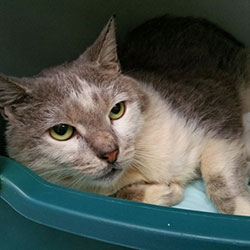
Background information
Name: Clouds
Age: 5 years
Breed: Feline
Gender: Male entire
Presenting reason
Re-homing
Physical examination
Bilateral Otodectes cynotis infection, evidence of flea allergic dermatitis and a visible feline odontoclastic resorptive lesion on tooth 407.
Rest of the physical exam was unremarkable. Clouds was treated with a topical spot-on anti-parasitic as well as an oral wormer. A topical ear preparation to treat otitis externa was applied bilaterally and Clouds was given his first vaccination.
One week after arriving at the rehoming centre it was noted by the nurses and kennel staff that Clouds had been quite obviously PU/PD since admission.
Initial lab results
A free catch urine sample revealed Leucocytes 125++, Protein +, pH 6.5, rest within normal limits. USG on refractometer was mildly reduced at 1.025.
A further cysto sample taken the following day revealed an even lower USG of 1.023 on refractometer, but Clouds exhibited no other supporting signs of cystitis or UTI.
Bloods were taken for biochemistry analysis.
| Total T4 | 10.9 | nmol/l | 7.5 - 55.0 | |
| Sodium | 152 | mmol/l | 140 - 157 | |
| Potassium | 4.0 | mmol/L | 3.4 - 5.6 | |
| Calcium | 2.5 | mmol/l | 1.6 - 3.0 | |
| Phosphate | 1.7 | mmol/L | 0.7 - 2.1 | |
| T Protein | 79 | g/l | 56 - 81 | |
| Albumin | 27 | g/l | 26 - 42 | |
| Globulin | 52 | g/L | 15 - 57 | |
| Urea | 11.2 | mmol/l | 6.1 - 12.5 | |
| Creatinine | 107 | mumol/L | 45 - 170 | |
| Bilirubin | 3 | umol/L | 0 - 10 | |
| Cholesterol | 4.3 | mmol/L | 0.9 - 6.5 | |
| ALT | H | 89 | u/l@37C | 18 - 77 |
| ALP | 34 | u/l@37C | 11 - 67 | |
| Glucose | 5.8 | mmol/L | 3.8 - 7.6 | |
| Amylase | H | 1251 | U/L | 200 - 1250 |
In the absence of azotaemia, Clouds underwent general anaesthesia for a routine castrate, de-scale and polish and extraction of tooth 407.
Post-op check
Continued PU/PD was observed; with an estimated water intake of 50mls/kg/24 hrs. Repeat free-catch urine dipstick revealed pH 8, leucocytes +3, few bacteria and leucocytes, rest of sediment exam and dipstick parameters within normal limits.
Urine specific gravity remained persistently low on refractometer at 1.020. A Minimum DataBase consisting of haematology, biochemistry (chem15), IDEXX SDMA, electrolytes and complete urinalysis were performed.
Assessment
Haematology results were unremarkable. Biochemistry revealed a mildly elevated globulin, urea, ALT, cholesterol and an elevated IDEXX SDMA of 20µg/dL.
Urinalysis showed isothenuria and dipstick abnormalities: blood +, pH 8. Sediment was unremarkable.
Clouds was treated with amoxicillin potentiated with clavulanic acid at a dose of 12.5mg/kg BID for 3 weeks to rule out pyelonephritis.
Lab results (05/12/15)
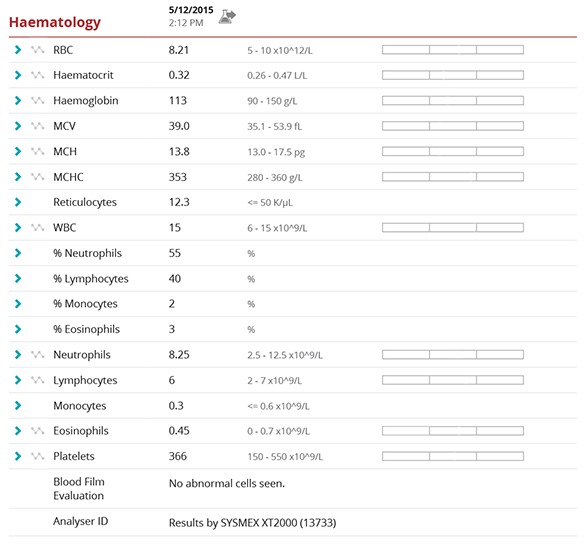
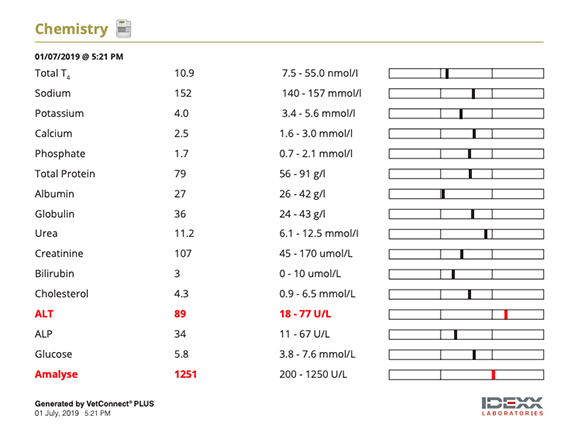
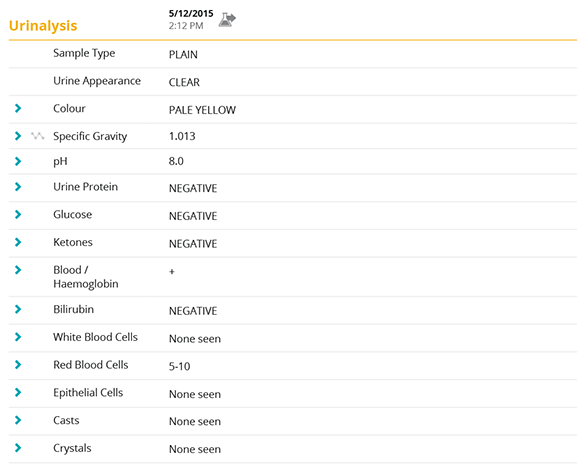
Discussion
A Minimum DataBase was repeated 7-10 days after completing antibiotics.
Results remained largely unchanged.
Download Cloud's laboratory results (09/01/2016)
SDMA typically increases when there is on average a 40% decrease in kidney function. This occurs earlier than creatinine, which doesn’t increase until there is up to 75% loss of kidney function. A persistently elevated IDEXX SDMA may therefore indicate chronic kidney disease even in the absence of azotaemia.
A persistently reduced USG is consistent with loss of urine concentrating ability, also supportive of a modest reduction in kidney function. Clinically, PU/PD remained.
Clouds was diagnosed with chronic kidney disease.
Once kidney disease is diagnosed we suggest a three-stage approach to the patient, IMM:
- Investigate for an underlying cause
- Manage
- Monitor
Investigate
Clouds was treated with antibiotics to rule out pyelonephritis as an underlying cause for his renal disease. Although Urine PH, haematuria and blood plasma globulin improved following the course of antibiotics, SDMA remained elevated and USG remained persistently decreased.
Pyelonephritis was not deemed to be an underlying cause in this case.
Clouds was tested for FIV/FeLV using a lateral flow pet-side test and was found to be negative for both of these disease states.
Imaging via bilateral renal ultrasound revealed no visible abnormalities (see below).
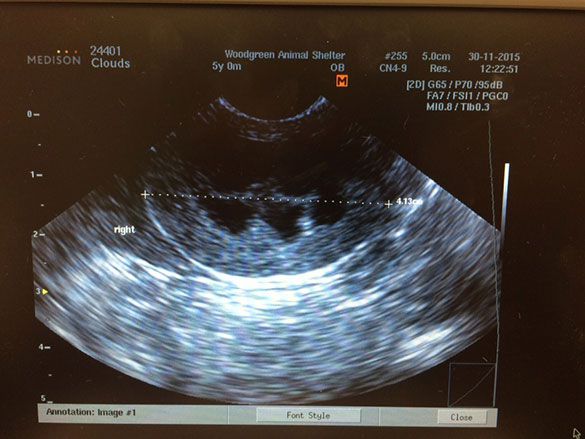
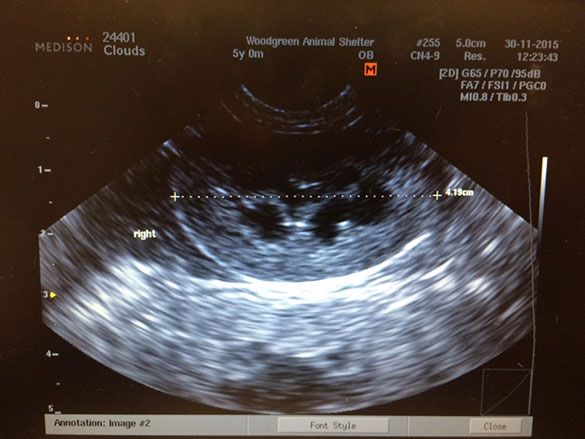
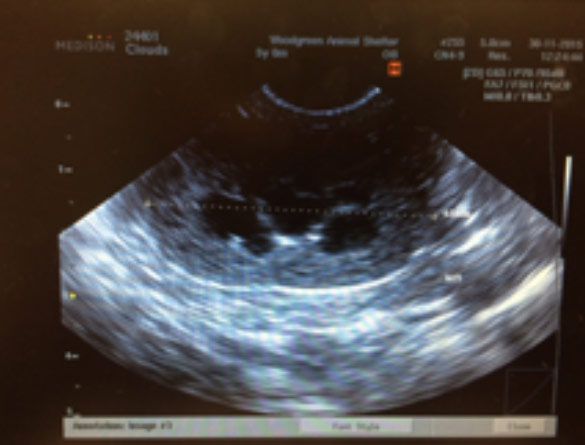
Urine protein creatinine levels were within normal limits as was systolic blood pressure.
Clouds was classified as IRIS stage one kidney disease.
Manage
Clouds was given a renal supportive diet (*IRIS recommends starting renal specific diet in stage 2) and the kennel staff ensured he had constant access to multiple clean water sources.
At a recheck examination Clouds had been observed to be eating the renal diet with enthusiasm. Clinically he had shown improvement: appearing outwardly healthy, his hair-coat was in much better condition and he had gained 300-400g in weight.
His water intake at this stage was difficult to interpret (Clouds tends to drink with his paw!) however some degree of PU/PD seemed to remain.
Monitor
Happily, Clouds good- looks and easy nature ensured he was not a stray for long! He was quickly selected by a new family and has since been re-homed; he is settling in well.
Clouds will continue to receive a renal supportive diet and he will be monitored by his new veterinary surgeon for improvement or progression of his renal disease, nephrotoxic drugs will be avoided.
Conclusions
This case highlights the importance of running a Minimum DataBase to obtain the full diagnostic picture.
As a result of earlier diagnosis Clouds’ owners are likely to have a healthier, happier cat with a longer life expectancy.